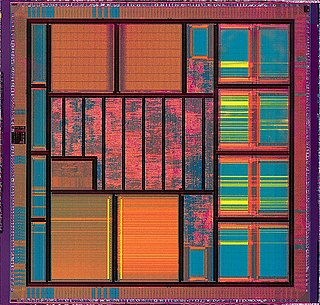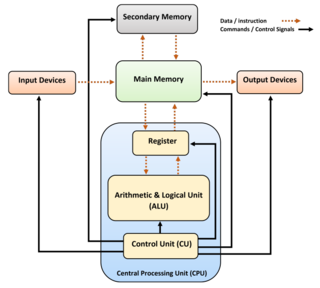Processor design is a subfield of computer science and computer engineering (fabrication) that deals with creating a processor, a key component of computer hardware.

A microprocessor is a computer processor for which the data processing logic and control is included on a single integrated circuit (IC), or a small number of ICs. The microprocessor contains the arithmetic, logic, and control circuitry required to perform the functions of a computer's central processing unit (CPU). The IC is capable of interpreting and executing program instructions and performing arithmetic operations. The microprocessor is a multipurpose, clock-driven, register-based, digital integrated circuit that accepts binary data as input, processes it according to instructions stored in its memory, and provides results as output. Microprocessors contain both combinational logic and sequential digital logic, and operate on numbers and symbols represented in the binary number system.

In computer science, a reduced instruction set computer (RISC) is a computer architecture designed to simplify the individual instructions given to the computer to accomplish tasks. Compared to the instructions given to a complex instruction set computer (CISC), a RISC computer might require more instructions in order to accomplish a task because the individual instructions are written in simpler code. The goal is to offset the need to process more instructions by increasing the speed of each instruction, in particular by implementing an instruction pipeline, which may be simpler to achieve given simpler instructions.

Very-large-scale integration (VLSI) is the process of creating an integrated circuit (IC) by combining millions or billions of MOS transistors onto a single chip. VLSI began in the 1970s when MOS integrated circuit chips were developed and then widely adopted, enabling complex semiconductor and telecommunication technologies. The microprocessor and memory chips are VLSI devices.
XScale is a microarchitecture for central processing units initially designed by Intel implementing the ARM architecture instruction set. XScale comprises several distinct families: IXP, IXC, IOP, PXA and CE, with some later models designed as system-on-a-chip (SoC). Intel sold the PXA family to Marvell Technology Group in June 2006. Marvell then extended the brand to include processors with other microarchitectures, like Arm's Cortex.

In electronics and especially synchronous digital circuits, a clock signal is an electronic logic signal which oscillates between a high and a low state at a constant frequency and is used like a metronome to synchronize actions of digital circuits. In a synchronous logic circuit, the most common type of digital circuit, the clock signal is applied to all storage devices, flip-flops and latches, and causes them all to change state simultaneously, preventing race conditions.
Asynchronous circuit is a sequential digital logic circuit that does not use a global clock circuit or signal generator to synchronize its components. Instead, the components are driven by a handshaking circuit which indicates a completion of a set of instructions. Handshaking works by simple data transfer protocols. Many synchronous circuits were developed in early 1950s as part of bigger asynchronous systems. Asynchronous circuits and theory surrounding is a part of several steps in integrated circuit design, a field of digital electronics engineering.
The PowerPC 400 family is a line of 32-bit embedded RISC processor cores based on the PowerPC or Power ISA instruction set architectures. The cores are designed to fit inside specialized applications ranging from system-on-a-chip (SoC) microcontrollers, network appliances, application-specific integrated circuits (ASICs) and field-programmable gate arrays (FPGAs) to set-top boxes, storage devices and supercomputers.

The R3000 is a 32-bit RISC microprocessor chipset developed by MIPS Computer Systems that implemented the MIPS I instruction set architecture (ISA). Introduced in June 1988, it was the second MIPS implementation, succeeding the R2000 as the flagship MIPS microprocessor. It operated at 20, 25 and 33.33 MHz.

The R4000 is a microprocessor developed by MIPS Computer Systems that implements the MIPS III instruction set architecture (ISA). Officially announced on 1 October 1991, it was one of the first 64-bit microprocessors and the first MIPS III implementation. In the early 1990s, when RISC microprocessors were expected to replace CISC microprocessors such as the Intel i486, the R4000 was selected to be the microprocessor of the Advanced Computing Environment (ACE), an industry standard that intended to define a common RISC platform. ACE ultimately failed for a number of reasons, but the R4000 found success in the workstation and server markets.

The R5000 is a 64-bit, bi-endian, superscalar, in-order execution 2-issue design microprocessor that implements the MIPS IV instruction set architecture (ISA) developed by Quantum Effect Design (QED) in 1996. The project was funded by MIPS Technologies, Inc (MTI), also the licensor. MTI then licensed the design to Integrated Device Technology (IDT), NEC, NKK, and Toshiba. The R5000 succeeded the QED R4600 and R4700 as their flagship high-end embedded microprocessor. IDT marketed its version of the R5000 as the 79RV5000, NEC as VR5000, NKK as the NR5000, and Toshiba as the TX5000. The R5000 was sold to PMC-Sierra when the company acquired QED. Derivatives of the R5000 are still in production today for embedded systems.
The transistor count is the number of transistors in an electronic device. It is the most common measure of integrated circuit complexity. The rate at which MOS transistor counts have increased generally follows Moore's law, which observes that transistor count doubles approximately every two years. However, being directly proportional to the area of a chip, transistor count does not represent how advanced the corresponding manufacturing technology is: a better indication of this is transistor density.
Titan was a planned family of 32-bit Power ISA-based microprocessor cores designed by Applied Micro Circuits Corporation (AMCC), but was scrapped in 2010. Applied Micro chose to continue development of the PowerPC 400 core instead, on a 40 nm fabrication process.

The Alpha 21164, also known by its code name, EV5, is a microprocessor developed and fabricated by Digital Equipment Corporation that implemented the Alpha instruction set architecture (ISA). It was introduced in January 1995, succeeding the Alpha 21064A as Digital's flagship microprocessor. It was succeeded by the Alpha 21264 in 1998.
The R2000 is a 32-bit microprocessor chip set developed by MIPS Computer Systems that implemented the MIPS I instruction set architecture (ISA). Introduced in January 1986, it was the first commercial implementation of the MIPS architecture and the first commercial RISC processor available to all companies. The R2000 competed with Digital Equipment Corporation (DEC) VAX minicomputers and with Motorola 68000 and Intel Corporation 80386 microprocessors. R2000 users included Ardent Computer, DEC, Silicon Graphics, Northern Telecom and MIPS's own Unix workstations.
The x704 is a microprocessor that implements the 32-bit version of the PowerPC instruction set architecture (ISA) developed by Exponential Technology. The microprocessor was notable for its high clock frequency in the range of 400 to 533 MHz, its use of bipolar transistors for logic and CMOS circuits for memory, and its failure to see use in an Apple Macintosh, the opposite of what industry observers such as Microprocessor Report expected. Exponential Technology eventually failed as a result of the x704's lack of success, but some of its former employees founded Intrinsity, a start-up that developed a high clock frequency MIPS implementation, FastMATH.

In computer science and computer engineering, computer architecture is a description of the structure of a computer system made from component parts. It can sometimes be a high-level description that ignores details of the implementation. At a more detailed level, the description may include the instruction set architecture design, microarchitecture design, logic design, and implementation.

The Apple A4 is a 32-bit package on package (PoP) system on a chip (SoC) designed by Apple Inc. and manufactured by Samsung. It was the first SoC Apple designed in-house. The first product to feature the A4 was the first-generation iPad, followed by the iPhone 4, fourth-generation iPod Touch, and second-generation Apple TV.
IBM Power microprocessors are designed and sold by IBM for servers and supercomputers. The name "POWER" was originally presented as an acronym for "Performance Optimization With Enhanced RISC". The Power line of microprocessors has been used in IBM's RS/6000, AS/400, pSeries, iSeries, System p, System i, and Power Systems lines of servers and supercomputers. They have also been used in data storage devices and workstations by IBM and by other server manufacturers like Bull and Hitachi.
Since 1985, many processors implementing some version of the MIPS architecture have been designed and used widely.










